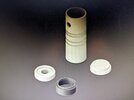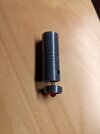Belgarion
New Member
Hello everyone,
I am a big tricorder fan. Especially of the Mk. X version from Voyager/First Contact. When I saw the prop for the first time, I was immediately hooked.
Over the years I have completed two FC/VOY tricorders myself, one the science and one the medical version. For the medical version I even developed the electronics myself, with a little help from my grandpa.
The bodies are from Stapleton and I find them very accurate. Unfortunately, the medical scanner was not included. So I thought about building it myself. I already have the 3D model ready (see pictures, printed in PLA).
What's giving me a headache now is the electronics. There is extremely limited space in the hand scanner. Normally I use a clock chip and a counter chip and transistors to generate the running lights. Unfortunately, there is not enough space for everything in the hand scanner. I thought about using an ATtiny85, but I would need transistors again, as the attiny cannot switch the LEDs directly.
Since I'm not getting anywhere with the problem, I wanted to ask here whether anyone has any good advice for me on how to get the electronics small enough to fit into the scanner or which parts you would recommend. Unfortunately, my grandfather was also a bit clueless. I saw some videos where people assembled a hand scanner but they didn't say anything about the electronics. Everything looked so compact there and I'm starting to get desperate because I can't find a solution on my own.
I look forward to tips and support.
Many thanks in advance!
I am a big tricorder fan. Especially of the Mk. X version from Voyager/First Contact. When I saw the prop for the first time, I was immediately hooked.
Over the years I have completed two FC/VOY tricorders myself, one the science and one the medical version. For the medical version I even developed the electronics myself, with a little help from my grandpa.
The bodies are from Stapleton and I find them very accurate. Unfortunately, the medical scanner was not included. So I thought about building it myself. I already have the 3D model ready (see pictures, printed in PLA).
What's giving me a headache now is the electronics. There is extremely limited space in the hand scanner. Normally I use a clock chip and a counter chip and transistors to generate the running lights. Unfortunately, there is not enough space for everything in the hand scanner. I thought about using an ATtiny85, but I would need transistors again, as the attiny cannot switch the LEDs directly.
Since I'm not getting anywhere with the problem, I wanted to ask here whether anyone has any good advice for me on how to get the electronics small enough to fit into the scanner or which parts you would recommend. Unfortunately, my grandfather was also a bit clueless. I saw some videos where people assembled a hand scanner but they didn't say anything about the electronics. Everything looked so compact there and I'm starting to get desperate because I can't find a solution on my own.
I look forward to tips and support.
Many thanks in advance!



